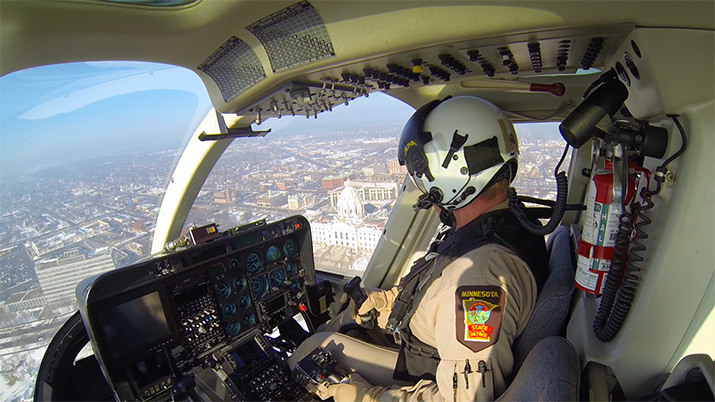Learn about the troopers who fly
April 26, 2018

A Marine Corps helicopter pilot. A couple of military aviation unit members. An airline flight school graduate turned city cop. Their backgrounds are varied, but they have one thing in common: They all joined the State Patrol’s aviation program. Interestingly, the majority of the State Patrol’s nine pilots weren’t pilots when they became troopers. After joining the State Patrol, they took lessons at local flight schools or flying clubs with flight instructors.
The State Patrol has two helicopters and four fixed-wing planes, with another helicopter on the way this fall. The six aircraft are shared between the State Patrol’s two flight bases in St. Paul and Brainerd. The pilots rotate the aircraft according to maintenance requirements and accumulated flight time—this way, they can choose the aircraft that is most suited to the mission without worrying whether it’s up to the task.
Both helicopters, for example are equipped with thermal imaging cameras, spotlights, and downlink capabilities to send camera images to the ground in real time. One helicopter, Trooper 8, also has a cargo hook, sliding rear doors and lifting capabilities for rescue operations. One of the fixed-wing planes also has a thermal imaging camera; it and the other planes are equipped with squad radios and are great for traffic enforcement, blood runs (i.e., bringing donated blood over long distances to patients who need it), personnel transport and training.
Anyone who decides they want to become a State Patrol pilot has to be a trooper for a minimum of five years with no suspensions without pay in the previous three years. On their last three annual performance evaluations, they need a “consistently meets expectations” rating in the Overall Contribution of Employee section.
A trooper who wants to fly for the State Patrol also needs a single-engine fixed-wing private pilot’s license with an instrument rating, along with at least 100 hours of flight experience in a single-engine fixed-wing plane.
If a trooper who wants to be a State Patrol pilot has these and a few other qualifications, they still need to pass a selection process. They submit a resume and their performance evaluations, then undergo an interview process with a selection board.
Once selected, trooper pilots have to live within 20 miles of their assigned base. Then they’re on a 12-month probationary period and they have to get their commercial pilot rating within the first nine months.
The road (or should we say flight path?) to becoming a State Patrol pilot is a long and arduous one, but the pilots themselves will tell you it’s worth it. That way state troopers are not only keeping Minnesotans safe on the roads—they’re doing so from the skies, as well!

